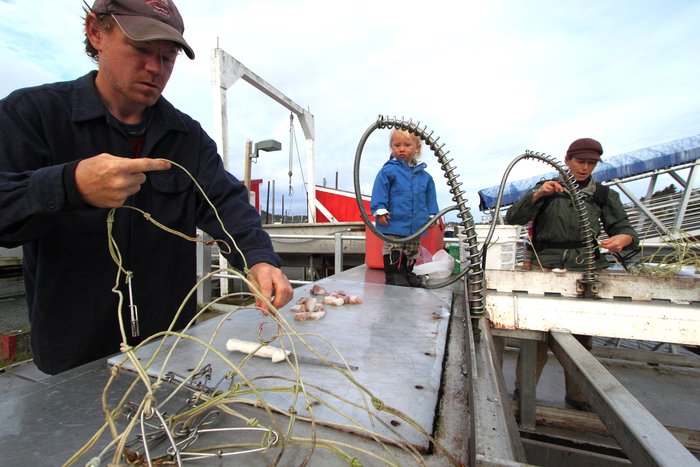
Summary
Herring have been historically harvested in Alaska for food, oil, bait and now sac roe (eggs). In addition to their commercial importance, herring act as a critical bridge between primary producers and the larger animals in the food web. Herring are still harvested throughout Alaska, but in Prince William Sound the fishery hasn’t recovered in the aftermath of the Exxon Valdez oil spill.

History
Pacific Herring ( Clupea pallasii ) has long been an important food staple in Alaska. The springtime collection of herring eggs was, and still is, an important subsistence resource in coastal communities. The commercial herring food fishery in Alaska began in 1878, with a much larger “reduction” fishery for herring oil starting soon afterwards. Use of herring for oil and fish meal declined in the 1950’s, and the last reduction plant in Alaska closed in 1966. During the 1950’s, large Japanese and Russian trawlers began fishing herring in the Bering Sea, and quickly grew to a large industry, reaching a peak catch of 320 million pounds in 1970. The trawl fishery ended after passage of the Magnuson Fishery Conservation and Management Act in 1976 which established the 200-mile Exclusive Economic Zone (EEZ) around the country. Commercial harvest of herring for bait began in the 1900’s and expanded in the 1970’s, corresponding to a large increase in the commercial crab fishery. Since the 1970’s, herring have been caught for sac roe, currently by far the principle use of Alaskan herring, and primarily exported to Japan.
Biology of Pacific Herring
Herring are a very important part of the food web in many ecosystems and are sometimes considered to be a “keystone” species. They connect the primary producers, such as algae and zooplankton, to larger predators, including other fish, birds, and marine mammals.
Unlike salmon, Pacific herring are capable of spawning in multiple years, a process which takes place as early as late March in southeast Alaska and can last into mid-July in Norton Sound on the Chukchi Sea. Herring spawn in protected bays and estuaries within the subtidal and intertidal regions, usually on kelp or other vegetation. Gulf of Alaska herring are a distinct population of Pacific herring and are much smaller and non-migratory compared to their Bering Sea counterparts.
Fishery Methods
The small food and bait herring fisheries remaining in Alaska use almost exclusively purse seine gear, while the much larger sac roe fishery uses both purse seine and gillnets. In both cases the herring are frozen right away and are sorted and processed later. Most fishermen use spotter aircraft to find schools of herring, a method so effective that in some areas the entire quota of thousands of tons of herring can be caught in as little as 15 minutes. In the spring, eggs are harvested from naturally occurring kelp beds or large batches of kelp placed into the water for the purpose of collecting them. Commercial fisheries for deposited herring eggs collect a few hundred thousand pounds of eggs per year statewide.
Prince William Sound Herring fishery
Prince William Sound in southcentral Alaska was once home to a large herring fishery, with catches in the tens of thousands of tons and reaching record levels in the late-1980’s. In the wake of the 1989 Exxon Valdez disaster, the herring population in the sound crashed in 1993. A partial recovery in the late 1990’s allowed the fishery to briefly re-open in 1997 and 1998, but the recovery was not robust, and the fishery has been closed since 1999. The extent to which the spill was responsible for the crash, and the lack of a subsequent recovery, is hotly debated.
The year of the oil spill had the lowest recruitment of herring ever measured in the Sound, and larval deformities and egg mortality were well-documented. However, three years of normal harvests followed before the stocks crashed. Herring populations fluctuate naturally. The size of the population is linked to many factors, including abundance of prey, predation, disease and environmental conditions. It is very difficult to say with certainty what role the spill played. More certain is the importance of herring to the food web, and the effect of their limited recovery on a large number of other organisms in the sound. For example herring are an important part of the diet for many seabirds as well as for salmon and other large predatory fish.
The Exxon Valdez Trustee Council, the organization tasked by the State of Alaska with studying the effects of the spill, considers understanding the herring population its most important outstanding issue, and has over a dozen research studies ongoing. The broad scientific consensus appears to be that the spill negatively impacted the herring and, most likely, indirectly caused the 1993 collapse. However, the inadequate recovery since the nineties is probably due to a combination of other factors, including a possible takeover of the ecological niche occupied by herring prior to the crash or predation by humpback whales.
Further Reading
- > Alaska Department of Fish and Game: Herring Fisheries in Alaska page
- > Commercial Fisheries in Alaska (2005) prepared by the Alaska Department of Fish and Game
- > Exxon Valdez Oil Spill Trustee Council page on Pacific herring
- > Resoration Notebook: Pacific Herring (1998) by the Exxon Valdez Oil Spill Trustee Council
Created: Jan. 19, 2018